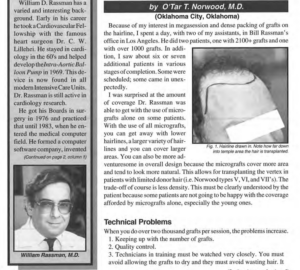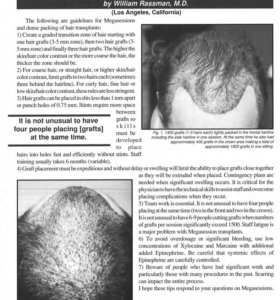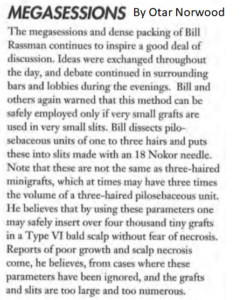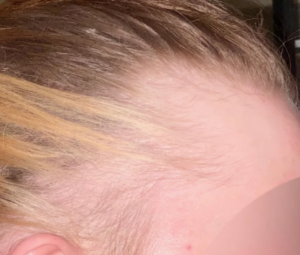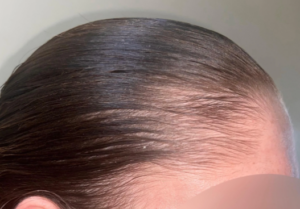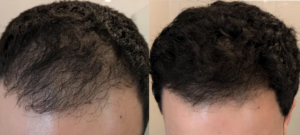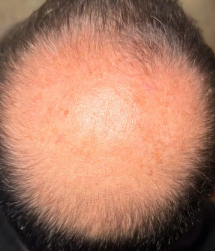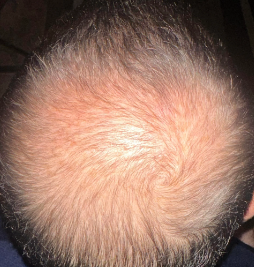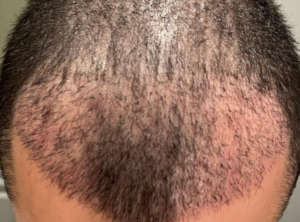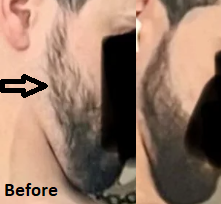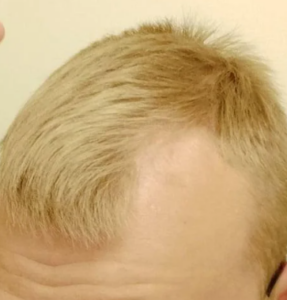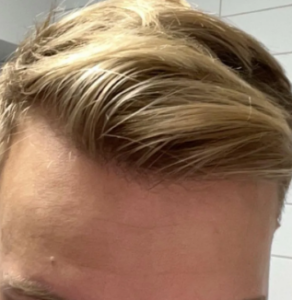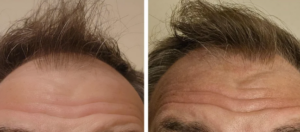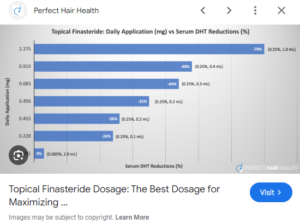Richard Shiell’s and Dr. O’tar Norwood’s comments were screenshots discussing my use of Megassions, transplanting between 2000-4000 graft. At that time, I was the only surgeon in the world performing 4000 grafts/sessions, publishing further on my early work in article #2 below. What I see in the screenshot of the photos of my patient, even meets my standards today, when most surgeons of the time were still performing plug surgery. You should know that performing such large procedures came at a great price to me, as I was relentlessly attacked at hair meetings because most other surgeons were still stuck in the “Plug Mentality,” performing 50-100 plugs per procedure. My surgeries could run 10 hours, but theirs ran about 1-3 hours, so it is easy to understand that they didn’t have the staff nor the skill to adopt these larger sessions with tiny grafts. The last article showed a compromise between an extensive session of plugs with some tiny grafts in the leading edge of the hairline (that wouldn’t work well for these patients, even at that time). Click to Enlarge the article you want to read, below.
I’ve been reading a lot about male pattern hair loss lately(androgenetic alopecia). Most often finasteride is said to be a requirement for hair loss and if you don’t use it, it’s an uphill battle.
From my understanding (if nutrition, hormones, exercise, etc is good) DHT causes hair loss due to reduced blood flow and shrinking of the hair follicle. If so, why wouldn’t minoxidil which increases blood flow and even brings back hairs from a baby state to a terminal hair during usage, be enough? Microneedling has a very similar effect, with great backing.
DHT blockers cause issues for many with varying effect. It changes your hormone levels, there’s no question about it. Most doctors I spoke to were against that as a young male, because of the terrible repercussions. I did however take Min + Fin solution for 3 weeks (local treatment, no pills). Did blood work and have higher estradiol. Will get further testing, but not interesting on messing myself. Off fin and will retest myself again after stabilization (month later). This question was taken from Reddit 12/15/2024 with my answer below.
I can’t write a textbook for you in answering your questions, so I am going to discuss only two classes of drugs, (1) DHT blockers and (2) Minoxidil.
DHT blockers work effectively at the hair follicle level blocking DHT in a competitive inhibition with the enzyme 5 alpha-reductase with 70% effectiveness for finasteride and greater than possibly greater than 90% with dustasteride. DHT works in many body organs, so blocking at the hair follicle level, will lead to blocking at other organ systems as well. Dutasteride blocks more receptors than finasteride and it has not been approved for hair loss by the FDA in the US. Finasteride was the first drug to be approved for DHT blocking hair loss drugs around 1996-7 timeframe.
Minoxidil was developed as an antihypertensive drug, which did not work consistently at controlling blood pressure; however, many women complained about hair growth on the face and body when taking it. When it was applied topically, it grew hair and less was absorbed systemically to impact blood pressure significantly. The mechanism of action is not that is increases blood flow as most people believe, it has its effect: by stimulating “ASC motility and increases paracrine growth factor signaling. Minoxidil-stimulated secretion of growth factors by ASCs that may enhance hair growth by promoting Dermal Papilla proliferation.” Further, “Minoxidil directly promotes hair growth via the stimulation of dermal papilla (DP) and epithelial cells. Reference: https://pmc.ncbi.nlm.nih.gov/articles/PMC5877552/
So, as you see from above, both classes of drugs have different modes of action to get to hair growth. Minoxidil has been around much longer, and in countries like India, it has been used well before finasteride was even discovered as a drug for treating hair loss in genetic balding. So if one drug doesn’t work, switch to the other, or sometimes take both.
Minoxidil does not work like microneedling, see here for mechanism of action: https://baldingblog.com/does-microneedling-really-work/
TI was starting my transition and noticed my mpb was beginning to progress faster, even though I was blocking my testosterone. On top of my temples receding, I also started showing signs of retrograde alopecia. My doctors still don’t know if it was telogen effluvium with an unknown cause or my androgenic alopecia worsening from stress. I got bloodwork done and my DHT levels had actually risen from when I first started my transition. So that’s why we added finasteride onto of the spiro.
I have seen minoxidil do this as well. The hairs are growing fairly forward on your hairline, too forward to reflect more than your original juvenile (female) hairline. I suspect this is a side effect of minoxidil reinforced by Estrogen. Do you have new hair growth in any other place on your body? If so, it suggests a minoxidil effect; if not, it would reflect a combined minoxidil and Estrogen effect. It would be interesting to see your 10-year-old hairline. That would shed light on where your hairline should be with all the changes you are precipitating.
Dr. Erdogan is possibly the best doctor in Turkey. These types of results are not uncommon in his hands. Congrats to both the doctor and the patient for this amazing result.
12 Month Update – Smile Hair Clinic – Dr. Erdogan
byu/doegotshwag intressless
Dr. Mohebi and I wrote this article a while ago, but I thought it was worthwhile to offer it to baldingblog readers.
https://www.ishrs-htforum.org/content/htfi/18/2/41.full.pdf
I’ve observed that I am definitely allergic to Finasteride, and my symptoms; 1- As soon as I wake up,I start sneezing, and I have a stuffy nose (not so bad but definitely stuffy) 2- I feel like I need at least one hour to wake myself up. The sneezing is the worst one, it starts at the morning and continues until around evening. Normally, I was having these symptoms every day, but I started taking EoD 1mg, it helped but not the way I wanted it to be. I am desperate for any suggestions or alternatives.
This is the first time I heard symptoms like your report; however, based upon your report, I would consider that this is possibly some allergic reaction. If you stop the oral finasteride, do the symptoms go away? You can switch to a topical liposomal finasteride in which as much as 82% of it stays in the scalp.
I had a hair transplant 21 days ago, and as I looked closely, I saw many gaps where there are no grafts. Did my surgeon not give me what I bought?
By the 21st day, I expect that many grafts will fall out in the ordinary course of healing. You didn’t mention how many grafts were put in, but these spaces probably had grafts in them. As they are shed after a hair transplant between 2 and 5 weeks after the procedure, they will grow when they go into their growth phase, usually 2-4 months from the day of surgery. You will know the fullness at 5-7 months from the surgery date. Don’t worry about this, as it should be okay if your surgeon’s team did it well.
I have read that the micro-scarring caused by derma-penning may prevent the new follicles from an HT from taking. Is this true?
I do not believe microneedling will cause enough damage, if any, to impact a hair transplant. The micro-scarring that may occur is at the very upper dermis, much higher than a hair transplant works.
As title asks, I feel like I can spot a transplant almost instantly because they get a juvenile hairline, and it gives it away straight away and unless your Ronald Reagan is unrealistic for most guys past the age of 25 . Im just wondering how a transplant surgeon would react if you asked for a mature hairline and how it would look.
Most people don’t know what normal is, so they unfortunately leave the final design of a hair transplant to the surgeon. Mature hairlines are slightly different in different men. The most striking difference is when the hairline independently recedes while they retain a persistent forelock in the juvenile location. This is where most surgeons make their mistakes because the retained forelock in the juvenile position may not be permanent, so decisions have to be made to account for the changes in the forelock position with age. Your surgeon must have a sense of art and balance and imagine how your hairline will change as you age.
Like Bill Clinton, a small percentage of the population retains their juvenile hairline into adulthood. When his hairline slightly receded, he still retained most of the juvenile hairline. For such men, I might restore the recession; however, I would never put back a juvenile hairline in an adult who doesn’t have one.
You must have a conversation with your surgeon BEFORE you agree to a hair transplant that you will be stuck with for the rest of your life. It is the most important decision when getting a frontal hair transplant. My hairline is the perfect mature hairline. Its location is the same distance from my glabella (the grove on the upper nose between your eyes) as the tip of my nose is from my chin. This rule is often broken by me when I do a hair transplant when I deal with a persistent forelock, but that is always a discussion I have with the patient before the surgery. (you can write to me at williamrassman33@gmail.com if you want a second opinion or just want to talk about your hairline situation).
I have experimented with other treatment options like microneedling, ketoconazole, and scalp massage, but not consistently whatsoever. This is basically only the result of finasteride with a dosage of 0.5mgs/day. The left side came back. The right side is little behind it.
Results like this are usually in young men in their early 20s or late teens. Great job!
So, I was doubting my progress until tonight when I pulled the pics on my 6 month anniversary date of starting min/ fin. I started receding 10 years ago and I know I waited too long to get my full hairline back or anything. I just wanted to stop thinning where I still have it. I think it’s pretty decent progress for an old white dude… or am I imagining it? Will it keep improving? Also, in the last pic, I sprouted a pretty thick base of vellus hairs. They keep multiplying and getting longer. And chance those eventually go terminal?! That would be a game-changer for a 40-year-old like me!
Pictures speak louder than words. This man is impressive because he started balding in his 30s. The only part of his hairline so far that comes back is the forelock. After a year, if only the forelock was stimulated, he could consider a hair transplant if he wanted it all back and it didn’t come back with drugs alone,
I’ve looked at a couple studies now, and it seems that of all the options out there that topical finasteride is now the safest route to hair regrowth. The studies I read basically found comparable hair regrowth compared to oral finasteride, but lowered plasma (blood) DHT by only 5-34%—compared to oral finasteride, which lowers plasma DHT by more like 50%. In other words, the topical really targets the scalp DHT, but doesn’t absorb as much into the blood.
Topical finasteride is dose-dependent as it passes through the skin in increasingly high doses. Without DHT blood levels, it is very difficult to know what you are actually delivering, and even with that, you might not know if it is working. Go to: https://perfecthairhealth.com/topical-finasteride-dosage/ and look at the graphics on delivered topical finasteride and the DHT levels found. These studies were done by Perfect Hair Health, very informative site.

